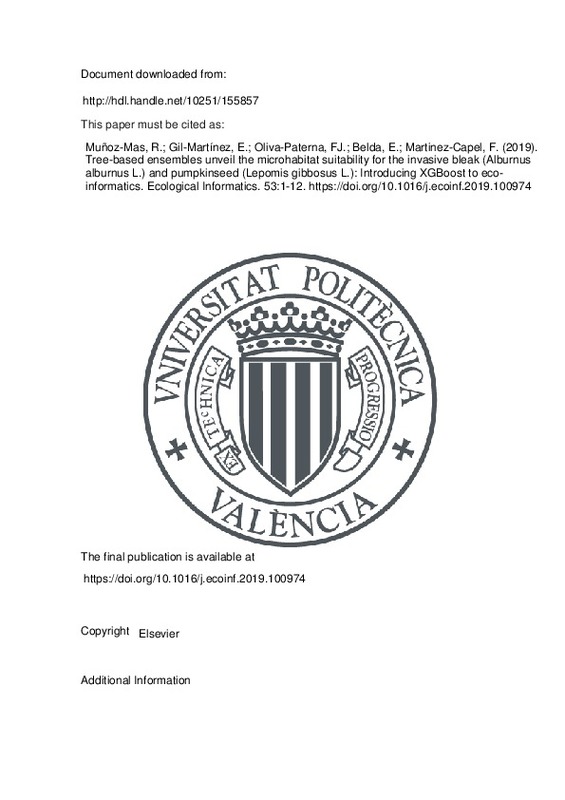JavaScript is disabled for your browser. Some features of this site may not work without it.
Buscar en RiuNet
Listar
Mi cuenta
Estadísticas
Ayuda RiuNet
Admin. UPV
Tree-based ensembles unveil the microhabitat suitability for the invasive bleak (Alburnus alburnus L.) and pumpkinseed (Lepomis gibbosus L.): Introducing XGBoost to eco-informatics
Mostrar el registro sencillo del ítem
Ficheros en el ítem
| dc.contributor.author | Muñoz-Mas, Rafael
|
es_ES |
| dc.contributor.author | Gil-Martínez, Enric
|
es_ES |
| dc.contributor.author | Oliva-Paterna, Francisco J.
|
es_ES |
| dc.contributor.author | Belda, E.J.
|
es_ES |
| dc.contributor.author | Martinez-Capel, Francisco
|
es_ES |
| dc.date.accessioned | 2020-11-26T04:32:14Z | |
| dc.date.available | 2020-11-26T04:32:14Z | |
| dc.date.issued | 2019-09 | es_ES |
| dc.identifier.issn | 1574-9541 | es_ES |
| dc.identifier.uri | http://hdl.handle.net/10251/155857 | |
| dc.description.abstract | [EN] Random Forests (RFs) and Gradient Boosting Machines (GBMs) are popular approaches for habitat suitability modelling in environmental flow assessment. However, both present some limitations theoretically solved by alternative tree-based ensemble techniques (e.g. conditional RFs or oblique RFs). Among them, eXtreme Gradient Boosting machines (XGBoost) has proven to be another promising technique that mixes subroutines developed for RFs and GBMs. To inspect the capabilities of these alternative techniques, RFs and GBMs were compared with: conditional RFs, oblique RFs and XGBoost by modelling, at the micro-scale, the habitat suitability for the invasive bleak (Alburnus alburnus L.) and pumpkinseed (Lepomis gibbosus L). XGBoost outperformed the other approaches, particularly conditional and oblique RFs, although there were no statistical differences with standard RFs and GBMs. The partial dependence plots highlighted the lacustrine origins of pumpkinseed and the preference for lentic habitats of bleak. However, the latter depicted a larger tolerance for rapid microhabitats found in run-type river segments, which is likely to hinder the management of flow regimes to control its invasion. The difference in the computational burden and, especially, the characteristics of datasets on microhabitat use (low data prevalence and high overlapping between categories) led us to conclude that, in the short term, XGBoost is not destined to replace properly optimised RFs and GBMs in the process of habitat suitability modelling at the micro-scale. | es_ES |
| dc.description.sponsorship | This project had the support of Fundacion Biodiversidad, of Spanish Ministry for Ecological Transition. We want to thank the volunteering students of the Universitat Politecnica de Valencia, Marina de Miguel, Carlos A. Puig-Mengual, Cristina Barea, Rares Hugianu, and Pau Rodriguez. R. Munoz-Mas benefitted from a postdoctoral Juan de la Cierva fellowship from the Spanish Ministry of Science, Innovation and Universities (ref. FJCI-2016-30829). This research was supported by the Government of Catalonia (ref. 2017 SGR 548). | es_ES |
| dc.language | Inglés | es_ES |
| dc.publisher | Elsevier | es_ES |
| dc.relation.ispartof | Ecological Informatics | es_ES |
| dc.rights | Reconocimiento - No comercial - Sin obra derivada (by-nc-nd) | es_ES |
| dc.subject | Conditional random forests | es_ES |
| dc.subject | EXtreme Gradient Boosting machine | es_ES |
| dc.subject | Gradient boosting machine | es_ES |
| dc.subject | Oblique random forests | es_ES |
| dc.subject | Random forests | es_ES |
| dc.subject | SMOTE | es_ES |
| dc.subject.classification | ZOOLOGIA | es_ES |
| dc.subject.classification | TECNOLOGIA DEL MEDIO AMBIENTE | es_ES |
| dc.title | Tree-based ensembles unveil the microhabitat suitability for the invasive bleak (Alburnus alburnus L.) and pumpkinseed (Lepomis gibbosus L.): Introducing XGBoost to eco-informatics | es_ES |
| dc.type | Artículo | es_ES |
| dc.identifier.doi | 10.1016/j.ecoinf.2019.100974 | es_ES |
| dc.relation.projectID | info:eu-repo/grantAgreement/Generalitat de Catalunya//2017 SGR 548/ | es_ES |
| dc.relation.projectID | info:eu-repo/grantAgreement/MINECO//FJCI-2016-30829/ | es_ES |
| dc.rights.accessRights | Abierto | es_ES |
| dc.contributor.affiliation | Universitat Politècnica de València. Departamento de Ingeniería Hidráulica y Medio Ambiente - Departament d'Enginyeria Hidràulica i Medi Ambient | es_ES |
| dc.contributor.affiliation | Universitat Politècnica de València. Instituto de Investigación para la Gestión Integral de Zonas Costeras - Institut d'Investigació per a la Gestió Integral de Zones Costaneres | es_ES |
| dc.contributor.affiliation | Universitat Politècnica de València. Departamento de Ciencia Animal - Departament de Ciència Animal | es_ES |
| dc.description.bibliographicCitation | Muñoz-Mas, R.; Gil-Martínez, E.; Oliva-Paterna, FJ.; Belda, E.; Martinez-Capel, F. (2019). Tree-based ensembles unveil the microhabitat suitability for the invasive bleak (Alburnus alburnus L.) and pumpkinseed (Lepomis gibbosus L.): Introducing XGBoost to eco-informatics. Ecological Informatics. 53:1-12. https://doi.org/10.1016/j.ecoinf.2019.100974 | es_ES |
| dc.description.accrualMethod | S | es_ES |
| dc.relation.publisherversion | https://doi.org/10.1016/j.ecoinf.2019.100974 | es_ES |
| dc.description.upvformatpinicio | 1 | es_ES |
| dc.description.upvformatpfin | 12 | es_ES |
| dc.type.version | info:eu-repo/semantics/publishedVersion | es_ES |
| dc.description.volume | 53 | es_ES |
| dc.relation.pasarela | S\394860 | es_ES |
| dc.contributor.funder | Fundación Biodiversidad | es_ES |
| dc.contributor.funder | Generalitat de Catalunya | es_ES |
| dc.contributor.funder | Ministerio de Economía y Competitividad | es_ES |
| dc.subject.ods | 15.- Proteger, restaurar y promover la utilización sostenible de los ecosistemas terrestres, gestionar de manera sostenible los bosques, combatir la desertificación y detener y revertir la degradación de la tierra, y frenar la pérdida de diversidad biológica | es_ES |







![[Cerrado]](/themes/UPV/images/candado.png)

